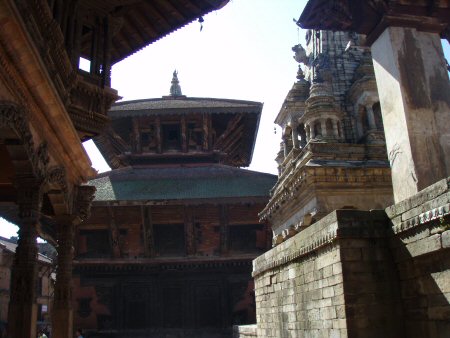 |
After walking through the old square, we emerged on the other side into the living city. Little cobblestone streets thronging with people and motorcycle traffic.
We don't fly to Lukla until tomorrow, so we have the day to see some of the sights of Kathmandu. Others have more energy, and have already been exploring on foot, but I am content to enjoy the bus tour.
| There
were twisty
little streets leading every which way. After
a few blocks there would be a square, with old
buildings all around.
Each square seemed to
be
different: one was selling pottery, one wood carving,one metal work,
one stone
carving, and so forth.
In between, there
was a continual flow of foot traffic, motor bikes, and occasional cars. They
went whizzing by at an impressive speed,
considering how crowded, narrow, and crooked the streets were. |
|
|
| Pottery Square |
|
All along each street
were storefronts, where
people were working or just selling their goods. |
|
| Painting |
| Lots of different
foodstuffs: teas, fish, lentils, vegetables. People
were carving, painting, weaving,
making the goods that they were selling. In
contrast to the vendors on the outskirts, the people in
town
were
friendly and welcoming.
I could imagine
this being how things were here 100, 200 years before (minus the
motorized
traffic).
|
|
|
| Lentils |
|
In one
of the
squares there was a shrine of some kind and there was a ceremony taking
place.
A series of plates of
food were
set out on the floor of the shrine, each one an elaborate combination
of food,
drink, and flowers.
Some of these were
being carried away after being blessed. I
wish I knew what was going on.
|
|
| Food Offerings |
|
Next we visited Patan, another one of the ancient kingdoms. This has become more of a suburb of Kathmandu, and its palace had become more of a city center. People were going about their business, crisscrossing the square on their way to wherever. Large wooden and stone palace buildings were present, more a part of things than in Bhaktapur. One of the palace buildings had been restored into a museum, and part of it was given over to a restaurant. | |
| Patan |
| Some of us had lunch, which was pretty mediocre. The rest wisely skipped lunch and explored more of the palace square. |
|
|
| Statue in Patan |